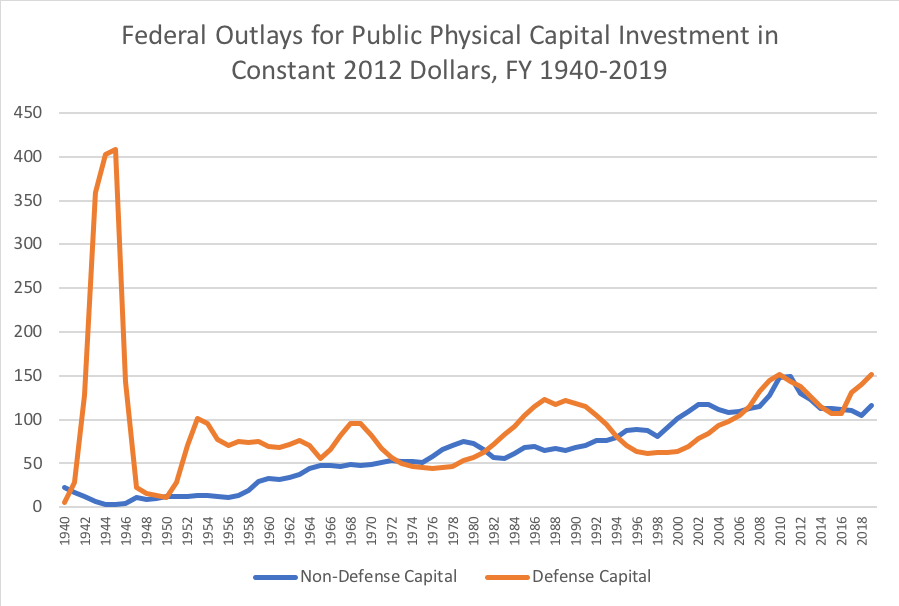May 10, 2019
As part of preparations for Infrastructure Week 2019, it’s worth looking at how a proposed $2 trillion infrastructure spending total would compare to past and present federal spending on infrastructure (however you want to define it).
Nominal dollars (not adjusted for inflation). Each year, OMB publishes a table (Table 9-6) showing outlays for all “public physical capital” grants to state and local governments, by type, going all the way back to 1940. No matter how you define infrastructure, it has to be a subset of public physical capital spending. Here is the sum total spending over the last 70 years (fiscal years 1949 through 2018), for certain types of public physical grants that people might think of as infrastructure-related:
| Federal grant outlays over |
Nominal |
| 70-year period (FY 1949 – FY 2018) |
Million $$ |
| Highway grants |
1,098,416 |
| Mass transit and rail grants |
275,201 |
| Airport grants |
87,991 |
| Other transportation grants |
2,787 |
| Water/sewer facilities grants |
132,895 |
| 1970s public works grants |
6,600 |
| Community development grants |
205,166 |
| Urban renewal grants |
13,527 |
| Housing assistance grants |
174,799 |
| TOTAL OUTLAYS OVER 70 YEARS |
1,997,382 |
So, basically, if you just look at nominal dollars, not adjusted for inflation, the federal government has only spent $2 trillion on infrastructure grants over 70 years, and the White House and Congressional leaders want to match that over the next 10 years.
Inflation-adjusted dollars. Obviously, the farther back one goes, the less the value of a dollar today holds up to the purchasing value of a dollar in days gone by. Those same OMB historical tables also include Table 9-2, which shows all federal spending on public physical capital over that same time period, including direct spending, for both defense and non-defense, over that time period, in both nominal dollars and constant 2012 dollars using sector-specific deflators shown in Table 10-1. Note that this includes equipment purchases, which is a huge deal for defense capital (planes, boats, tanks and bombs) and is also a substantial chunk of non-defense capital.
This chart shows total federal public physical capital spending, in inflation-adjusted 2012 dollars, since 1940.

On the defense side, one can easily see World War II, the spike for Korea and Vietnam, the Reagan defense buildup, peak Iraq/Afghanistan, and then the new Trump/GOP defense buildup. On the non-defense side, the growth rate was steadier, up until a sharp spike around the time of the ARRA stimulus, then a steady decline since then (arrested starting in 2019). Pulling out the non-defense line for the last 20 years (FY 2000 – 2019) makes the ARRA spike clearer:

In constant dollars, because of the upswing in anticipated FY 2019 outlays that stem from the bipartisan budget deal in 2018-2019, the federal government will be spending the same amount, roughly, on non-defense capital that it did during the George W. Bush administration ($116 billion in 2019 vs a Dubya peak of $118 billion in 2003). In real 2012 dollars, even 2018’s $104 billion is significantly higher than average non-defense capital spending under the Clinton Administration (an average of $91 billion per year over fiscal 1994 – 2001).
Just focusing on transportation infrastructure. Last fall the Congressional Budget Office updated its massively useful report on transportation and water infrastructure spending, by all levels of government, since 1956. (CBO now lets you download the spreadsheet with the raw numbers, which is really nice.) The CBO report converts past spending to 2017 dollars based on very specific producer price indices that relate specifically to the cost of building and maintaining transportation and water infrastructure (not some generic GDP deflator or, worse, CPI which has absolutely no bearing on the price of concrete and steel).
According to this CBO report, total federal capital spending on transportation and water infrastructure over the 62-year period from fiscal 1956 to fiscal 2017, in constant 2017 dollars, totaled almost $4.2 trillion:
|
Million |
|
2017 $$ |
| Highways |
2,552,969 |
| Mass Transit |
362,270 |
| Rail |
72,615 |
| Aviation |
322,848 |
| Water Transportation |
53,961 |
| Water Resources |
433,616 |
| Water Utilities |
360,691 |
| TOTAL |
4,158,970 |
Over the last 10 years covered by the CBO report (FY 2008-2017), total federal capital spending on transportation and water infrastructure totaled $749 billion. An additional $2 trillion infrastructure plan would be at least $2.5 times that amount (considering that future dollars will lose some value each year).
As the following chart taken from the CBO data shows, while highway funding has been the mainstay of federal transportation and water infrastructure capital funding over the years, its cash flow, in real dollars, has had a lot of peaks and valleys. (Also note that Congress got into grants to water utilities in a huge way in the 1970s, but in the 1980s that was largely converted into low-interest loan programs, which no longer show up in the budget as spending, for the most part).







